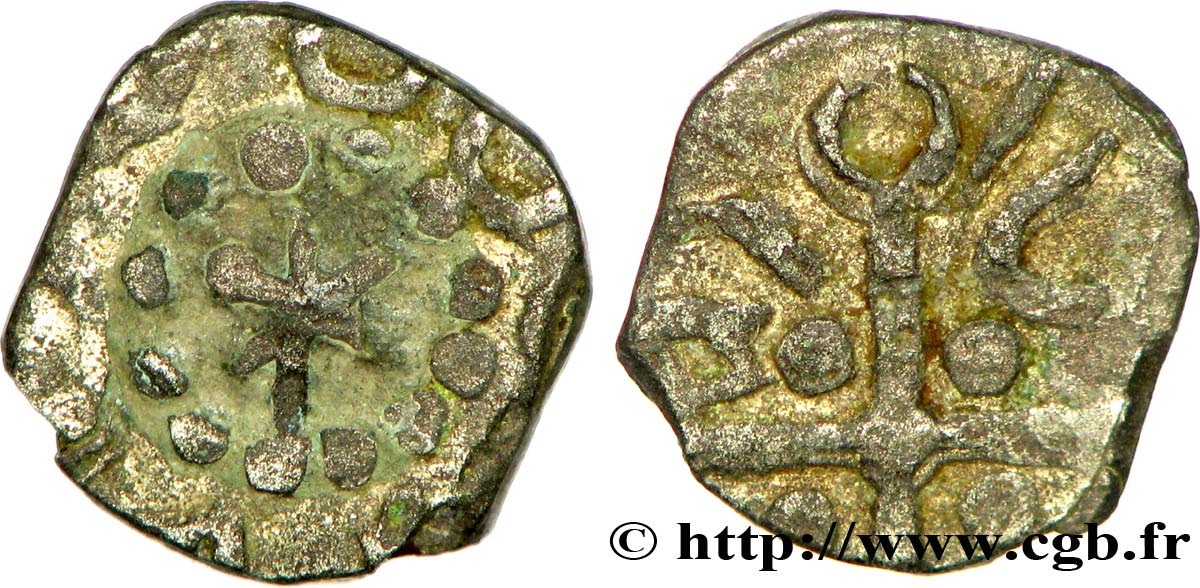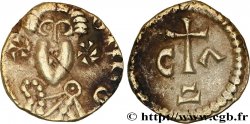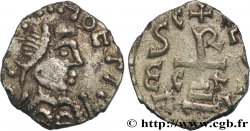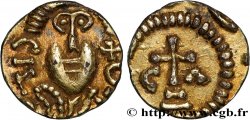v38_1684 - CHALON - SUR - SAÔNE (CABILONNUM) Denier à la croix
MONNAIES 38 (2009)
起拍价 : 350.00 €
估价 : 550.00 €
未售出的物品
起拍价 : 350.00 €
估价 : 550.00 €
未售出的物品
种类 Denier à la croix
日期: (VIIIe siècle)
铸币厂名称/城市 71 - Chalon-sur-Saône
材质 silver
直径 10,5 mm
重量 1,19 g.
稀少度 R2
关于品相的说明
Denier sur un flan un peu court et assez angulaire. Droit confus avec une oxydation de surface ou une très légère gangue verte. Revers de qualité et de frappe vigoureuse, mais avec un métal cristallisé et poreux. Patine grise, irisée par endroit
出版目录中的项代码 :
正面
正面的文字 LÉGENDE INDÉTERMINÉE.
正面的说明书 Croix à six branches dans un grènetis ; légende autour.
背面
背面的说明书 Croix cantonnée d’un globule dans chaque canton ; légende en quatre parties.
评论
Comme pour le denier précédent, le nom du monétaire ne peut pas être restitué.
Le revers, légèrement décentré sur la partie inférieure, semble présenter la même caractéristique au premier canton, comme si la légende était centrifuge. Tous les deniers répertoriés par le Vte Ponton d’Amécourt semblent pourtant avoir la légende centripète, comme c’est le cas au revers du bronze de TEVDEBERTE (le prototype de cette série en argent).
Tous ces deniers dérivent du bronze TEVDEBERTE / CA-BI-LON-NV (cf. Ponton d'Amécourt, pl. VI, n° 132) attribué à Théodebert Ier. La croix à six branches est considérée par certains comme étant un chrisme. Les deniers de Chalons sont classés selon le nom inscrit au droit ; BADOINVS, MVMMOLVS, MAROL, BIL...INVS, ABBO, NERTVNVS, INPORTVNVS ou BOBO. Mis à part cette inscription du droit, l'évolution de l'épigraphie CABILONNO, au revers, permet de proposer une datation relative. La chronologie proposée par Ponton d'Amécourt est la suivante ; CA BI LON NV, CA BIL ON NO, CA BL ON NO, puis enfin CA BLO NN O+.
Sur notre denier, la légende (largement hors flan) peut difficilement être restituée.
Le revers, légèrement décentré sur la partie inférieure, semble présenter la même caractéristique au premier canton, comme si la légende était centrifuge. Tous les deniers répertoriés par le Vte Ponton d’Amécourt semblent pourtant avoir la légende centripète, comme c’est le cas au revers du bronze de TEVDEBERTE (le prototype de cette série en argent).
Tous ces deniers dérivent du bronze TEVDEBERTE / CA-BI-LON-NV (cf. Ponton d'Amécourt, pl. VI, n° 132) attribué à Théodebert Ier. La croix à six branches est considérée par certains comme étant un chrisme. Les deniers de Chalons sont classés selon le nom inscrit au droit ; BADOINVS, MVMMOLVS, MAROL, BIL...INVS, ABBO, NERTVNVS, INPORTVNVS ou BOBO. Mis à part cette inscription du droit, l'évolution de l'épigraphie CABILONNO, au revers, permet de proposer une datation relative. La chronologie proposée par Ponton d'Amécourt est la suivante ; CA BI LON NV, CA BIL ON NO, CA BL ON NO, puis enfin CA BLO NN O+.
Sur notre denier, la légende (largement hors flan) peut difficilement être restituée.








 对产品描述纠错
对产品描述纠错 打印
打印 分享我的选择
分享我的选择 提问
提问 Consign / sell
Consign / sell
 产品介绍
产品介绍
